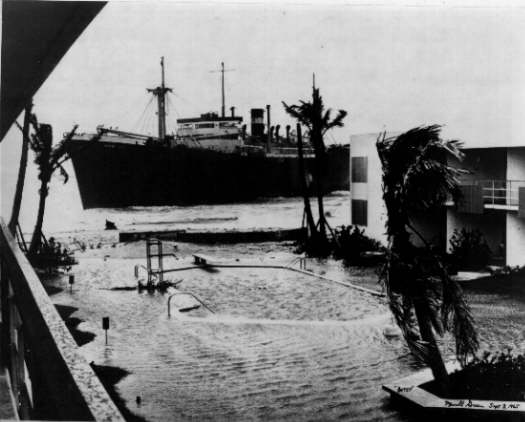
- Other Issues
- >> The Gulfstream Issue
- >> The Wreck of the Amaryllis
South Florida Dive Journal Advanced Site for the Sport Diver: The Wreck of the Amaryllis...
 The day was September 9th, 1965. Gale force winds whipped the normally calm seas off Singer Island into a frenzied nightmare of 20 foot breakers and 80 mph winds. Palm trees leaned horizontally away from the onslaught, but many uprooted and were sent soaring by gusts of unthinkable velocity. A lone ship struggled against uncertain odds. The Amaryllis was nearing the safety of the Palm Beach Inlet, but found itself being literally blown into the shallow waters less than a mile from the beach. The crew made desperate attempts to compensate for the winds and the storm damaged steering, but the gale worsened to a full fledged hurricane, and the foundering ship grounded on the shore immediately in front of the Rutledge Inn. An irresistible force of impossibly large waves crashed relentlessly upon the great ship as it lay stranded upon the inundated area which was once a huge beach. A terrified crew remained stranded aboard her--- abandonment now, in the height of a full scale hurricane in the dead of night, would be suicide...should the great ship capsize or break up, certain death for her crew would result. Beyond help, they huddled through the night in desperation, praying for an end to the hurricane and the first light of dawn. Ugly, monstrous waves rushed toward Singer Island. Up, up and over the beach, over the swimming pools, through the hotel lobbies, over parking lots across the street and then assaulting the intercoastal waterway on the other side of the island. As dawn broke, so did the fury of the storm. Where last night had been a beautiful beach, now rested the storm beaten wreck of the Greek banana freighter, Amaryllis. The Rutledge had itself become an island, surrounded by ocean, with a huge 450 foot ship parked beside it. As the storm subsided and the exhausted crew rescued, it soon became evident that that this great ship would be resting here for some time. |
 A little more than three years later, the foundered ship was finally removed from the beach, and towed out to its final resting spot about one half mile from shore in about 75 feet of water. Many of Palm Beach's early scuba divers were on hand to witness the sinking, and to dive on one of Palm Beach's first artificial reefs. Today the wreck is safe within a protected zone, an underwater metropolis, teeming with life and constant action. It is bathed constantly by the Gulf Stream, and lies just outside a marine estuary -a place where salt water species enter brackish water to spawn. If you know your marine biology, you know that this brings an enormous food chain into the immediate proximity of the Amaryllis. As good as this dive is in the day time, advanced divers find night dives on it to be even more spectacular. Squids, bioluminescent life, black tip sharks, moray eels, and a million new faces show themselves to the night. The Amaryllis is waiting for you. The complex ecosystem which has become the Amaryllis, represents a profusion of marine life which does not exist in the Caymans, Islands like Jamaica, or the Florida Keys. To the dive travelers who try the unknown underwater wilderness of Palm Beach, and who dare to unleash a hurricane of passion within themselves, a rediscovery of diving awaits! |
Click here for mpeg video...then keep yourself occupied over the next 10 minutes while the 1.1 meg file downloads to your viewer
(C) 1994 South Florida Dive Journal, CyberBeach Publishing, and CyberGate Inc. |